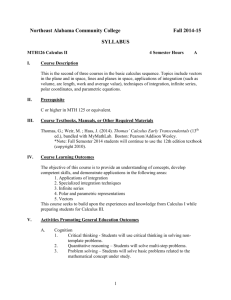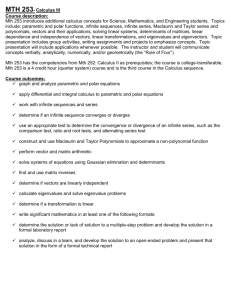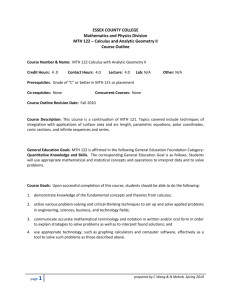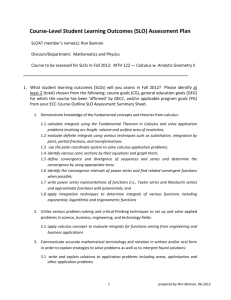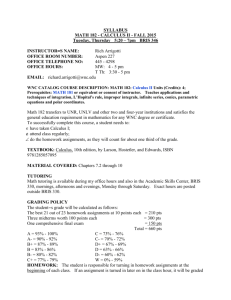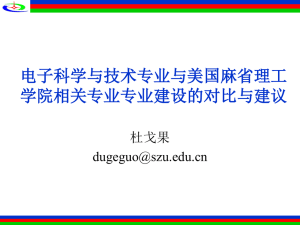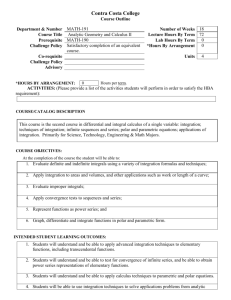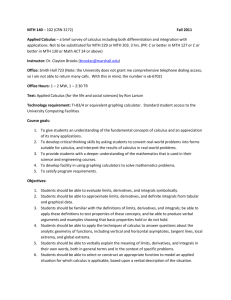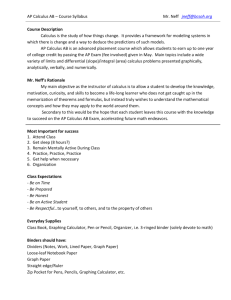Math 122 - Calculus with Analytic Geometry II
advertisement
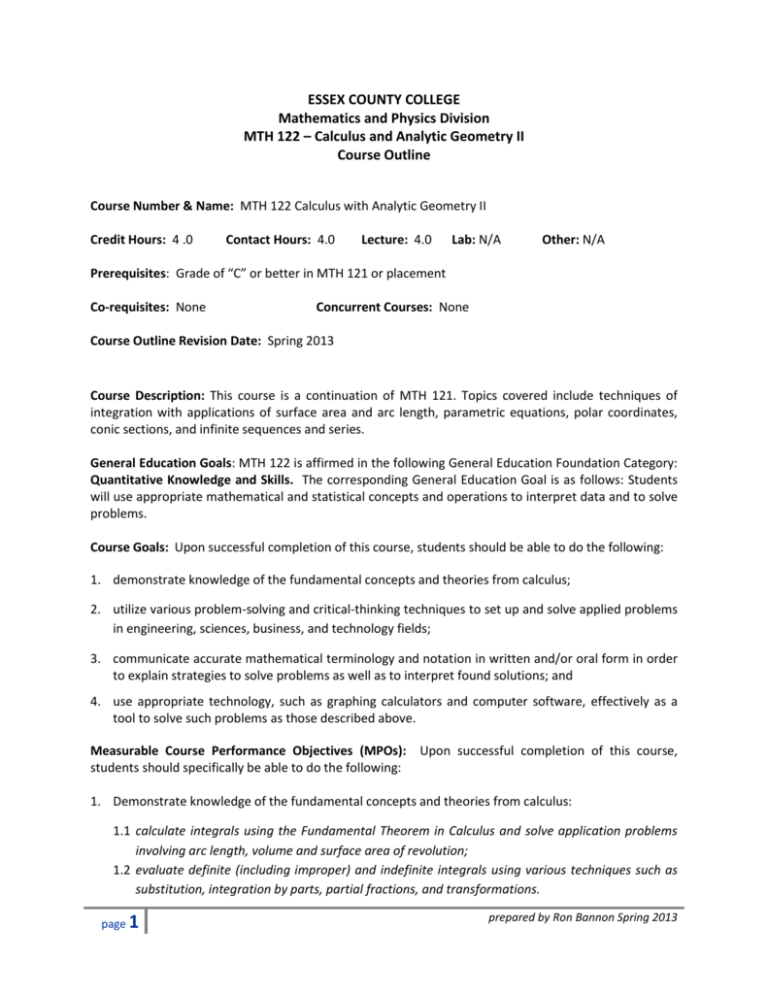
ESSEX COUNTY COLLEGE Mathematics and Physics Division MTH 122 – Calculus and Analytic Geometry II Course Outline Course Number & Name: MTH 122 Calculus with Analytic Geometry II Credit Hours: 4 .0 Contact Hours: 4.0 Lecture: 4.0 Lab: N/A Other: N/A Prerequisites: Grade of “C” or better in MTH 121 or placement Co-requisites: None Concurrent Courses: None Course Outline Revision Date: Spring 2013 Course Description: This course is a continuation of MTH 121. Topics covered include techniques of integration with applications of surface area and arc length, parametric equations, polar coordinates, conic sections, and infinite sequences and series. General Education Goals: MTH 122 is affirmed in the following General Education Foundation Category: Quantitative Knowledge and Skills. The corresponding General Education Goal is as follows: Students will use appropriate mathematical and statistical concepts and operations to interpret data and to solve problems. Course Goals: Upon successful completion of this course, students should be able to do the following: 1. demonstrate knowledge of the fundamental concepts and theories from calculus; 2. utilize various problem-solving and critical-thinking techniques to set up and solve applied problems in engineering, sciences, business, and technology fields; 3. communicate accurate mathematical terminology and notation in written and/or oral form in order to explain strategies to solve problems as well as to interpret found solutions; and 4. use appropriate technology, such as graphing calculators and computer software, effectively as a tool to solve such problems as those described above. Measurable Course Performance Objectives (MPOs): Upon successful completion of this course, students should specifically be able to do the following: 1. Demonstrate knowledge of the fundamental concepts and theories from calculus: 1.1 calculate integrals using the Fundamental Theorem in Calculus and solve application problems involving arc length, volume and surface area of revolution; 1.2 evaluate definite (including improper) and indefinite integrals using various techniques such as substitution, integration by parts, partial fractions, and transformations. page 1 prepared by Ron Bannon Spring 2013 1.3 use the polar coordinate system and parametric system to solve calculus application problems; 1.4 identify various conic sections by their equations and graph them; 1.5 define convergence and divergence of sequences and series and determine the convergence by using appropriate tests; 1.6 identify the convergence intervals and radii of power series and find related convergent functions when possible; 1.7 write power series representations of functions (i.e., Taylor series and Maclaurin series) and approximate functions with polynomials; and 1.8 apply integration techniques to determine integrals of various functions including exponential, logarithmic and trigonometric functions 2. Utilize various problem-solving and critical-thinking techniques to set up and solve applied problems in science, business, engineering, and technology fields: 2.1 apply calculus concepts to evaluate integrals for functions arising from engineering and business applications 3. Communicate accurate mathematical terminology and notation in written and/or oral form in order to explain strategies to solve problems as well as to interpret found solutions: 3.1 write and explain solutions to problems including series, areas, and other application problems 4. Use appropriate technology, such as graphing calculators and computer software, effectively as a tool to solve such problems as those described above: 4.1 use a graphing calculator and/or web-based application programs such as Wolfram Alpha as an aid to calculus concepts covered; and 4.2 use Computer Algebra Systems (CAS), and other computer software such as Mathematica and/or Maple as an aid to calculus concepts covered. Methods of Instruction: Instruction will consist of a combination of lectures, class discussion, group work, board work, computer lab work, and individual study. Outcomes Assessment: Test and exam questions are blueprinted to course objectives. Data is collected and analyzed to determine the level of student performance on these assessment instruments in regards to meeting course objectives. The results of this data analysis are used to guide necessary pedagogical and/or curricular revisions. Course Requirements: All students are required to: 1. Read the textbook and do the suggested review problems in a timely manner. 2. Be an active participant in all classes. 3. Complete all written and/or electronic homework and adhere to assignment deadlines. 4. Take exams/quizzes in class and adhere to the exam/quiz schedule. page 2 prepared by Ron Bannon Spring 2013 Methods of Evaluation: Final course grades will be computed as follows: Grading Components Homework e.g., problem sets, research projects, etc., designed to enhance understanding of applications of calculus in engineering and related disciplines. 3 or more Exams/Quizzes (dates specified by the instructor) Exams/quizzes will show evidence of the extent to which students meet course objectives, including, but not limited to, identifying and applying concepts, analyzing and solving problems, estimating and interpreting results, and stating appropriate conclusions using correct terminology. Final Exam The comprehensive final exam will examine the extent to which students have understood and synthesized all course content and achieved all course objectives. % of final course grade 10 – 20% 50 – 60% 20 – 30% NOTE: The instructor will provide specific weights, which lie in the above-given ranges, for each of the grading components at the beginning of the semester. Also, students may use a scientific or graphing calculator or laptop computer to enhance understanding during class or while doing homework. However, technological aids may only be used on select assessments (exams, quizzes, etc.) – instructors will inform students in advance when these technological aids are needed and may be used. Academic Integrity: Dishonesty disrupts the search for truth that is inherent in the learning process and so devalues the purpose and the mission of the College. Academic dishonesty includes, but is not limited to, the following: plagiarism – the failure to acknowledge another writer’s words or ideas or to give proper credit to sources of information; cheating – knowingly obtaining or giving unauthorized information on any test/exam or any other academic assignment; interference – any interruption of the academic process that prevents others from the proper engagement in learning or teaching; and fraud – any act or instance of willful deceit or trickery. Violations of academic integrity will be dealt with by imposing appropriate sanctions. Sanctions for acts of academic dishonesty could include the resubmission of an assignment, failure of the test/exam, failure in the course, probation, suspension from the College, and even expulsion from the College. Student Code of Conduct: All students are expected to conduct themselves as responsible and considerate adults who respect the rights of others. Disruptive behavior will not be tolerated. All students are also expected to attend and be on time all class meetings. No cell phones or similar electronic devices are permitted in class. Please refer to the Essex County College student handbook, page 3 prepared by Ron Bannon Spring 2013 Lifeline, for more specific information about the College’s Code of Conduct and attendance requirements. Course Content Outline: based on the text Calculus: Early Transcendentals, 2nd edition, by Rogawski; published by Freeman, 2012; ISBN-10 #: 1-4292-0838-4; ISBN-13 #: 978-1-4292-0838-3. Class Meeting1 Chapter/Section 1 (1) 1 (2) 1 (3) 1 (4) CHAPTER 6 APPLICATIONS OF THE INTEGRATAL 6.1 Area Between Two Curves 6.2 Setting Up Integrals 6.3 Volumes of Revolution 6.4 Method of Cylindrical Shells 2 (6) 2 (8) 2 (10) 2 (12) 2 (14) 2 (16) CHAPTER 7 TECHNIQUES OF INTEGRATION 7.1 Integration by Parts 7.2 Trigonometric Integrals 7.3 Trigonometric Substitution 7.5 Method of Partial Fractions 7.6 Improper Integrals 7.8 Numerical Integration 1 (17) Testing 1 (18) 2 (20) CHAPTER 8 FURTHER APPLICATIONS 8.1 Arc length 8.4 Taylor Polynomials 1 (21) Testing 2 (23) 2 (25) 2 (27) 2 (29) 2 (31) 2 (33) CHAPTER 10 INFINITE SEQUENCE AND SERIES 10.1 Sequences 10.2 Summing an Infinite Series 10.3 Convergence of Series with Positive Terms 10.4 Absolute and Conditional Convergence 10.5 The Ratio and Root Tests 10.6 Power Series 10.7 Taylor Series 1 (34) Testing 3 (35) CHAPTER 11 PARAMETRIC EQUATIONS AND POLAR COORDINATES 11.1 Parametric Equations 1 A guide is available at: http://mth122.mathography.org/. The numbers in parenthesis are cumulative class periods (80 minutes = 1 class period). The class time does not have to follow this exact schedule. page 4 prepared by Ron Bannon Spring 2013 2 (37) 3 (40) 2 (42) 3 (45) 11.2 11.3 11.4 11.5 1 (46) Review 1 (48) Testing Arc Length and Speed Polar Coordinates Areas and Arc Lengths in Polar Coordinates Conic Sections MTH 122 Suggested Homework/Review Problems NOTE: The format used below is assignment #. chapter.section.exercise # 1. 6.1.005, 6.1.013, 6.1.017, 6.1.020, 6.1.035 2. 6.2.013, 6.2.039, 6.2.046 3. 6.3.004, 6.3.012, 6.3.016 4. 6.4.007, 6.4.008, 6.4.018 5. 7.1.008, 7.1.010, 7.1.012, 7.1.014, 7.1.019, 7.1.020, 7.1.025, 7.1.027, 7.1.030, 7.1.049 6. 7.2.001, 7.2.003, 7.2.007, 7.2.009, 7.2.013, 7.2.023, 7.2.047, 7.2.048, 7.2.050, 7.2.072 7. 7.3.005, 7.3.006, 7.3.011, 7.3.021, 7.3.022, 7.3.036, 7.3.039 8. 7.5.001, 7.5.002, 7.5.003, 7.5.004, 7.5.005, 7.5.009, 7.5.012, 7.5.017, 7.5.022, 7.5.065 9. 7.6.002, 7.6.004, 7.6.006, 7.6.011, 7.6.016, 7.6.017, 7.6.024, 7.6.029, 7.6.033, 7.6.040 10. 7.8.002, 7.8.011, 7.8.014, 7.8.030 11. 8.1.002, 8.1.007, 8.1.010, 8.1.015, 8.1.018, 8.1.035, 8.1.037, 8.1.039, 8.1.043 12. 8.4.003, 8.4.004, 8.4.005, 8.4.007, 8.4.010, 8.4.013, 8.4.025, 8.4.026 13. 10.1.003, 10.1.005, 10.1.009, 10.1.012, 10.1.013, 10.1.014d, 10.1.016, 10.1.017, 10.1.018, 10.1.019, 10.1.020, 10.1.022, 10.1.024, 10.1.025, 10.1.026, 10.1.030, 10.1.031, 10.1.036, 10.1.039, 10.1.041, 10.1.044, 10.1.045, 10.1.046, 10.1.048, 10.1.050, 10.1.054, 10.1.058, 10.1.059, 10.1.061, 10.1.065 14. 10.2.002, 10.2.004, 10.2.011, 10.2.012, 10.2.013, 10.2.015, 10.2.024, 10.2.025, 10.2.026, 10.2.029, 10.2.032, 10.2.043, 10.2.046 15. 10.3.007, 10.3.009, 10.3.012, 10.3.019, 10.3.025, 10.3.041, 10.3.043, 10.3.052, 10.3.055, 10.3.057, 10.3.060, 10.3.077 16. 10.4.001, 10.4.002, 10.4.003, 10.4.004, 10.4.005, 10.4.007, 10.4.009, 10.4.010, 10.4.011, 10.4.012, 10.4.017, 10.4.019, 10.4.020, 10.4.026 17. 10.5.001, 10.5.003, 10.5.006, 10.5.008, 10.5.009.SA, 10.5.012, 10.5.013, 10.5.016, 10.5.018, 10.5.030, 10.5.037, 10.5.038, 10.5.039, 10.5.040, 10.5.043 18. 10.6.001, 10.6.002, 10.6.007, 10.6.009, 10.6.010, 10.6.015, 10.6.026, 10.6.029, 10.6.033, 10.6.036, 10.6.045, 10.6.047a, 10.6.048, 10.6.051, 10.6.052, 10.6.053 19. 10.7.001, 10.7.003, 10.7.005, 10.7.007, 10.7.012, 10.7.014, 10.7.015, 10.7.019, 10.7.021, 10.7.024, 10.7.025, 10.7.033, 10.7.035, 10.7.042, 10.7.053 20. 11.1.001, 11.1.003, 11.1.007, 11.1.008, 11.1.010, 11.1.013, 11.1.014, 11.1.019, 11.1.020b, 11.1.027.SA, 11.1.049, 11.1.051, 11.1.054, 11.1.060, 11.1.061 21. 11.2.001, 11.2.007, 11.2.008, 11.2.010, 11.2.016, 11.2.017, 11.2.029, 11.2.032 page 5 prepared by Ron Bannon Spring 2013 22. 11.3.004, 11.3.005a, 11.3.006, 11.3.008, 11.3.010, 11.3.011, 11.3.012, 11.3.013, 11.3.014, 11.3.015, 11.3.051, 11.3.053 23. 11.4.001, 11.4.003, 11.4.005, 11.4.006, 11.4.007, 11.4.008, 11.4.010, 11.4.014, 11.4.015, 11.4.017 24. 11.5.001, 11.5.003, 11.5.005, 11.5.007, 11.5.011, 11.5.013, 11.5.015, 11.5.019, 11.5.020, 11.5.021, 11.5.025, 11.5.032, 11.5.033, 11.5.036, 11.5.044. page 6 prepared by Ron Bannon Spring 2013

